Intervertebral Foramina Stenosis: Causes and Treatments
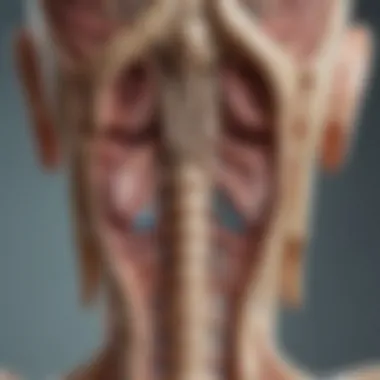

Intro
Stenosis of the intervertebral foramina refers to the narrowing of the spaces through which spinal nerves exit the vertebral column. This condition can initiate a cascade of complications, particularly nerve compression, which may culminate in neurological symptoms affecting the limbs and spine. Understanding the intricacies of this condition—not just the biological underpinnings but also the broader implications for quality of life—is crucial for healthcare professionals, educators, and students in the medical field. In this analysis, we aim to cover every nook and cranny of stenosis of intervertebral foramina, shedding light on its anatomy, causes, symptoms, diagnosis, treatment options, and post-operative care strategies.
Research Overview
Summary of Key Findings
In examining stenosis of the intervertebral foramina, several key findings emerge:
- Anatomical Considerations: The foramina play a pivotal role in spinal nerve function. Their dimensions can significantly influence the likelihood of nerve compression, often contingent on factors such as age, degenerative changes, and genetics.
- Symptoms: Patients may experience a range of symptoms, including pain, numbness, and weakness in the extremities. The manifestation of these symptoms can vary greatly depending on which specific nerves are affected.
- Diagnostic Methods: Modern imaging techniques, such as MRI and CT scans, offer detailed insights into foraminal stenosis, aiding in accurate diagnosis and management.
- Treatment Pathways: Both non-surgical and surgical interventions can mitigate symptoms and improve patient outcomes. The choice between these options often hinges on the severity of the condition and the patient’s overall health.
Relevance to Current Scientific Discussions
Stenosis of the intervertebral foramina resonates within a wider discourse on spinal health and neurology. As individuals age, understanding the impact of lifestyle choices—like physical activity and posture—on spinal health has gained traction. Moreover, this condition raises questions about the balance between treatment efficacy and patient quality of life.
As healthcare systems evolve, it becomes ever more important to emphasize preventive strategies and patient education. Hence, discussions surrounding this condition not only encompass clinical findings but also incorporate social and behavioral considerations.
Methodology
Research Design and Approach
To address the various facets of stenosis of the intervertebral foramina, a multidisciplinary approach was implemented. This comprised literature reviews, clinical case studies, and analyses of current best practices in treatment methodologies. By synthesizing various viewpoints and findings, we aim to provide a holistic view of the condition.
Data Collection and Analysis Techniques
Data collection was executed through:
- Comprehensive literature databases, including PubMed and Cochrane Library.
- Interviews with healthcare professionals specializing in spinal disorders.
- Patient surveys aimed at uncovering the lived experience of those afflicted with foraminal stenosis.
Quantitative and qualitative methods were applied to analyze this data, allowing for robust conclusions regarding the condition’s impact on patients.
The research highlights the complex interplay between anatomical structures and neurological health, emphasizing that a decline in intervertebral foramina space can significantly compromise nerve function and, consequently, the patient’s quality of life.
This section lays the groundwork for deepening our understanding of stenosis and prepares us to navigate the various implications presented in the upcoming discussions. Each aspect discussed herein aims to contribute to a larger narrative, enriching our grasp of this multifaceted subject.
Preface to Intervertebral Foramina
The interplay between the spine and its functional components is a cornerstone in understanding human anatomy and health. Within this intricate system, the intervertebral foramina have a pivotal role that cannot be overlooked. These foramina, small openings between adjacent vertebrae, serve as critical passageways for nerves and blood vessels to reach various parts of the body. This introduction sets the stage to discuss not just the anatomy but also the functionality that these foramina provide in maintaining the communication and operational integrity of the nervous system.
Understanding what intervertebral foramina are and why they are important lays the groundwork for a more profound exploration of stenosis. When these foramina become narrowed, as occurs in stenosis, it can directly affect nerve conduction, leading to a spectrum of symptoms. Recognizing the definition and anatomy of intervertebral foramina is essential when analyzing the broader implications of stenosis on neurological health and quality of life.
Definition and Anatomy
The intervertebral foramina are openings located on the lateral aspects of the vertebrae, found between each adjacent pair. Their precise structure, shaped respectively by the superior and inferior vertebral notches, permits the safe passage of spinal nerves from the spinal cord to peripheral areas. Each foramen is lined with a fibrous tissue, allowing some flexibility but primarily acting as a shield for the enclosed nerves. This protective characteristic is crucial, as the foramina’s size is directly correlated with the health of the nerves passing through.
A keen understanding of these anatomical features aids medical professionals in diagnosing conditions relating to foraminal stenosis. Furthermore, any degenerative changes in the vertebral column can lead to pathological changes that compromise the size and functionality of these foramina.
Function in the Nervous System
The main function of the intervertebral foramina is to facilitate the travel of spinal nerves out of the vertebral canal. When one considers the far-reaching implications of nerve pathways, the importance of these foramina becomes even clearer. Acts as conduits for the emergence of nerves that control motor and sensory functions, their health is paramount for maintaining overall systemic connectivity.
When the foramina are obstructed or narrowed, it can lead to conditions such as radiculopathy, where the affected nerve is compressed, leading to pain, tingling, or numbness which can radiate along the nerve’s path. Indeed, pressure on spinal nerves can evoke symptoms ranging from mild discomfort to debilitating pain, shedding light on the essential function of intervertebral foramina in the nervous system.
"The integrity of intervertebral foramina is vital not only for nerve function but also for overall mobility and quality of life."
Understanding these elements equips both patients and providers with critical insights into the treatment and management of foraminal stenosis. As we transition into more intricate aspects of stenosis, a comprehensive grasp of these foundational elements is indispensable.
Understanding Stenosis
Understanding stenosis is a critical piece to grasp when diving into the complexities of intervertebral foramina. Stenosis refers to the narrowing that's happening within these openings, resulting in various downstream effects that are not merely anatomical, but also functional and symptomatic. As medical professionals and educators, acknowledging the nuances of stenosis enriches our diagnostic approach and treatment methodologies. This section aims to equip you with deeper insights into the pathophysiology and classifications of this condition.
Pathophysiology of Stenosis
Stenosis in the intervertebral foramina leads primarily to nerve compression. This compression can stem from a variety of causes, leading to a cascade of physiological events. To understand this, one must first consider the anatomy. The foramina are spaces between the vertebrae where spinal nerves exit and importance of these nerves can't be overstated – they facilitate communication between the brain and various body parts.
When there’s a narrowing of these foraminal spaces, the nerves can get compressed, leading to ischemia and, ultimately, damage. The resulting symptoms can fluctuate from mild discomfort to acute pain radiating down an extremity, often dependent on the severity of the stenosis.
One could liken this process to trying to push too much water through a narrow pipe; at some point, pressure builds up, leading to what we could call "backflow" – in this case, sending pain signals up through the nerve. This pathophysiological understanding is crucial, as it underpins not just the symptoms that patients experience but also the treatment pathways one might consider.
Types of Stenosis
Stenosis can be broadly classified into several categories, each reflecting different underlying conditions, anatomical adjustments, and implications:
- Degenerative Stenosis: This is often wear-and-tear related, typically seen in older populations. As we age, the discs between vertebrae can dehydrate, causing the vertebrae to move closer together, narrowing the foramen space.
- Congenital Stenosis: This one is congenital, meaning individuals are born with narrower than normal foramina. It might not always produce symptoms early in life but can become significant later on, especially under stress from physical activity.
- Post-Traumatic Stenosis: Injuries can also bring about stenosis. Fractures or dislocations can misalign the vertebrae, reducing the space available for the nerves.
- Inflammatory Stenosis: Conditions like rheumatoid arthritis lead to swelling and can affect nerve passageways.
Each type presents its own set of challenges and treatment options. For instance, while degenerative stenosis might respond well to conservative management like physical therapy, congenital forms may require surgical intervention to restore normal nerve function.
Understanding these distinct types of stenosis not only aids in diagnosing patients effectively but also highlights the importance of personalized treatment strategies. The more we know about what we’re dealing with, the better equipped we are to provide precise care.
Causes of Intervertebral Foraminal Stenosis
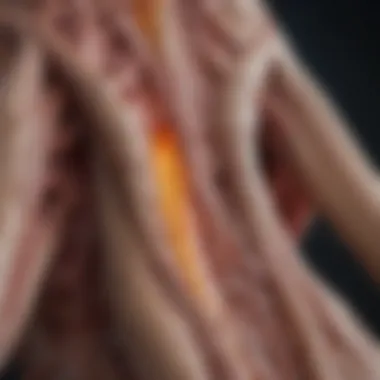
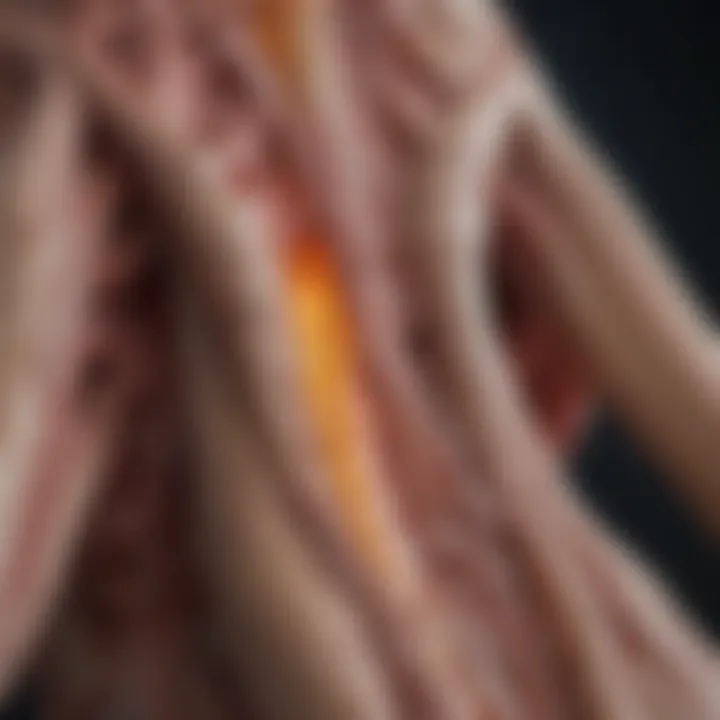
Understanding the causes of foraminal stenosis is key to addressing the challenges it presents. Stenosis can significantly impact a person's quality of life, making it crucial for medical professionals to recognize the underlying factors contributing to this condition. In this section, we will unpack the primary causes that lead to the narrowing of these vital openings through which nerves exit the spinal column.
Degenerative Changes
Degenerative changes are often the main culprits behind intervertebral foraminal stenosis. As we age, the spine inevitably undergoes wear and tear. Here are a few key aspects:
- Disc Degeneration: The intervertebral discs lose hydration and elasticity, leading to reduced disc height. This reduction can bring the vertebrae closer together, narrowing the foramina.
- Bone Spurs: With aging, the body often reacts to disc degeneration by forming bone spurs, or osteophytes. These growths can encroach on the foramina, further squeezing nerves that pass through.
- Thickened Ligaments: Ligaments can become thicker and stiffer over time, and in particular, the ligamentum flavum can contribute to foraminal narrowing.
It's notable how lifestyle plays a part in this degeneration. Individuals engaged in repetitive motions or heavy lifting might see a quicker onset of these changes. Thus, prevention strategies such as regular exercise focusing on back strength can be beneficial.
Trauma and Injuries
Trauma can strike without warning, often leading to immediate changes in the spinal structure. Injuries can manifest in multiple ways:
- Fractures: A fracture in the vertebrae can lead to misalignment, thus narrowing the foraminal space. This is particularly risk-prone in high-impact sports or in falls, leading to urgent medical evaluations.
- Herniated Discs: An acute injury might cause a disc to herniate, which can bulge into the foraminal area, compressing the nerves. The pain and neurological symptoms resulting from a herniated disc can be profound and often necessitate prompt treatment.
- Soft Tissue Damage: Injuries don’t just affect bones; muscles, tendons, and ligaments can be damaged as well. Soft tissue swelling can lead to an inflammatory response, causing the foramina to become narrower.
Recognizing the aftermath of trauma is vital for rehabilitative strategies. Properly treated injuries can lead to successful recovery, but severe cases may result in lasting effects on spinal health.
Congenital Factors
Some individuals may be born with anatomical factors that predispose them to stenosis. This can be a less discussed aspect, yet it is equally important:
- Spinal Canal Size: Some people naturally have a smaller spinal canal, which can predispose them to foraminal stenosis as they age. This is often dubbed as congenital stenosis.
- Vertebral Shape: Abnormalities in vertebral shape can lead to compromised foraminal gaps. Conditions like scoliosis or kyphosis can influence the amount of space available for nerve exit.
Many congenital factors often remain unnoticed until symptoms arise later in life. It's worth noting that, since these conditions are intrinsic, preventative measures may be more about management and regular monitoring.
"Understanding the causes of foraminal stenosis can significantly improve diagnosis and treatment strategies, ultimately benefiting patient outcomes."
In summary, the causes of intervertebral foraminal stenosis include degenerative changes, trauma, and congenital factors. Recognizing these triggers serves as the stepping stone for effective management of the condition.
Symptoms Associated with Foraminal Stenosis
Understanding the symptoms associated with foraminal stenosis is crucial. It helps to pinpoint how this condition affects individuals on a daily basis. The narrowing of the intervertebral foramina can lead to various symptoms that span physical discomfort, neurological issues, and functional impairments. Recognizing these symptoms is not just about identifying the condition but also about tailoring treatment approaches that genuinely improve patient outcomes and quality of life.
Pain Manifestations
One of the most immediate and notable symptoms of foraminal stenosis is pain. This pain can be localized or radiate along the course of the affected nerves, often resembling what patients may describe as an electric shock or a persistent ache. Different patients experience varying levels of pain intensity, which can be influenced by underlying factors such as age and physical activity levels.
- Localized Pain: Often centered around the area of stenosis, can lead to significant discomfort during daily activities.
- Radicular Pain: This occurs when nerve roots get compressed, causing the pain to travel down the arms or legs. It is sometimes described as a sharp pain that may feel like shooting or burning.
For some patients, movements like bending or twisting can exacerbate pain levels. As a result, pain management becomes a focus in treatment plans, potentially involving medications and physical therapy.
Neurological Deficits
The compression of nerve roots due to foraminal stenosis can manifest as neurological deficits. Symptoms may include tingling sensations, numbness, or weakness in the limbs. This aspect can severely impact everyday functions—tasks that require fine motor skills may be particularly affected.
- Tingling and Numbness: Commonly referred to as "paresthesia," this symptom often presents as a pins-and-needles sensation that can be not only uncomfortable but also frustrating.
- Muscle Weakness: Weakness in the affected areas can alter a person's ability to perform physical activities, leading to dependency on others for assistance in routine tasks.
Acknowledging these deficits is important as they can lead to a decreased quality of life. Patients may require supportive therapies to manage these neurological impacts effectively.
Impact on Mobility
Foraminal stenosis is notorious for impacting a person's mobility. When pain, weakness, or numbness come into play, everyday movement can turn into a daunting challenge. Patients often report:
- Difficulty Walking: Stenosis in the lumbar region can create challenges in maintaining balance and stability while walking.
- Limited Range of Motion: Many individuals notice physical restrictions, which can lead to compensatory movements that strain other body areas.
The ability to perform daily activities, such as climbing stairs or carrying groceries, often diminishes as mobility declines. This aspect of the condition emphasizes the need for not only symptomatic treatment but also therapeutic interventions aimed at enhancing physical function.
Managing these symptoms effectively not only improves patient comfort but significantly enhances engagement in everyday life.
Understanding these symptomatology elements is critical for practitioners in formulating a holistic care approach tailored to individual needs and fostering meaningful improvement in patient quality of life.
Diagnosis of Intervertebral Foraminal Stenosis
Diagnosing foraminal stenosis is a crucial step in managing this condition effectively. An accurate diagnosis can help healthcare providers understand the severity of nerve compression and determine appropriate treatment strategies. Proper diagnosis often involves a combination of clinical evaluations and advanced imaging techniques that can reveal critical details about spinal anatomy and any existing abnormalities. The goal is to identify the root causes of the stenosis, the specific structures involved, and the best path forward for the patient’s recovery.
Clinical Evaluation
The clinical evaluation of intervertebral foraminal stenosis starts with a thorough patient history. During this assessment, physicians explore various aspects such as the onset, duration, and characteristics of symptoms. Patients often describe a spectrum of conditions, from localized pain to widespread neurological deficits. Some aspects that warrant attention include:
- Nature of Pain: Is it sharp, dull, intermittent, or constant?
- Radiating Symptoms: Are there any numbness or tingling sensations extending to limbs?
- History of Trauma: Past injuries may provide clues to the current condition.
During the physical examination, healthcare providers look for signs of weakness, reflex abnormalities, and sensory deficits. Tests might include checking range of motion, performing strength assessments, and noting any pain reproduction. This combination of thorough history taking and physical examination lays the groundwork for further diagnostic procedures.
Imaging Techniques
Accurate imaging is indispensable for understanding the finer details of foraminal stenosis. Various imaging techniques allow practitioners to visualize the spine and discern anatomical abnormalities that may lead to stenosis.
MRI
MRI, or Magnetic Resonance Imaging, is widely preferred for diagnosing intervertebral foraminal stenosis. Unlike X-rays, MRI provides detailed images of soft tissues, including discs, nerves, and muscles surrounding the spinal column. Key characteristics of MRI include:
- Sensitive to Soft Tissue Changes: This feature allows identification of disk herniation, ligament thickening, and related issues that may compress nerves.
- No Ionizing Radiation: That's a safety boon for patients.


However, MRI does come with drawbacks, such as longer scanning times and potential discomfort for patients who are claustrophobic. Yet the detailed images produced by MRI are often pivotal in forming a comprehensive view of the patient's condition.
CT Scan
Computed Tomography (CT) scans are another valuable tool in diagnosing foraminal stenosis. They offer more clarity than standard X-rays and can visualize bony structures with precision. Highlights of CT Scans:
- Quick Imaging Process: Compared to MRI, CT scans are faster and can be more comfortable for patients.
- Excellent for Bony Assessments: This makes it easier to see bony spurs or other osseous changes contributing to stenosis.
However, CT scans do expose patients to radiation, which is a factor to consider when deciding on imaging methods. It's often used in conjunction with other imaging techniques to give a more complete picture.
X-rays
X-rays are less informative for foraminal stenosis specifically but can still play a role in the preliminary assessment. They are excellent for ruling out other bone-related issues. The characteristics of X-rays include:
- Quick and Accessible: They are generally more accessible in various medical settings and can be taken relatively quickly.
- Good for Checking Alignment: Useful for assessing the general alignment of the spine and any visible bony abnormalities.
However, X-rays only provide a two-dimensional view, which can mask subtle yet significant problems like soft tissue issues causing nerve compression.
Electrophysiological Studies
Electrophysiological studies, including electromyography (EMG) and nerve conduction studies, can also contribute to providing a more complete picture. These tests help assess the electrical activity of muscles and the speed of nerve conduction. With such insights, healthcare providers are better positioned to evaluate the functional impact of foraminal stenosis on a patient's daily life.
In summary, the synergy of clinical evaluation and imaging techniques is essential for accurately diagnosing intervertebral foraminal stenosis. Identifying this condition promptly can pave the way for effective treatment and enhance patient quality of life.
Conservative Management of Symptoms
Conservative management of symptoms associated with stenosis of the intervertebral foramina is paramount in optimizing patient outcomes. This approach serves as a first line of defense against the debilitating effects of nerve compression. Non-invasive strategies prioritize relief from pain, improvement in functionality, and enhancement of quality of life. The benefits of conservative management are manifold, as they tend to minimize the need for surgical interventions and empower patients to actively participate in their recovery.
Physical Therapy Approaches
Physical therapy plays a critical role in addressing the symptoms caused by foraminal stenosis. Through tailored exercises, therapists help patients regain strength, flexibility, and range of motion. These approaches can include:
- Stretching Exercises: Focused on the back and neck, these exercises aim to alleviate tightness and promote mobility.
- Strengthening Exercises: Targeted to reinforce the muscles surrounding the spine, enabling better support and stability.
- Postural Training: Educating patients on maintaining proper alignment can significantly reduce strain on affected areas.
Physical therapists employ techniques that are customized based on individual needs. For instance, some patients may benefit from aquatic therapy given the buoyancy and resistance of water, which can ease the strain on the spine while allowing for effective movement. While these methods require commitment and patience, they can yield significant improvement over time. A well-structured physical therapy program not only alleviates symptoms but also informs patients about self-management strategies that they can utilize outside the clinic.
Pharmacologic Treatments
While physical therapy is invaluable, pharmacologic treatments can provide important adjunctive care for managing pain and inflammation. A few common options include:
- Nonsteroidal Anti-Inflammatory Drugs (NSAIDs): Medications like ibuprofen or naproxen are typically the first stop for managing pain due to inflammation.
- Corticosteroids: In some cases, doctors may recommend corticosteroid injections to provide substantial relief by reducing swelling in the foraminal region.
- Muscle Relaxants: These can relieve acute muscle spasms, which may occur as a reaction to nerve compression.
Utilizing medications wisely is crucial, as they can offer temporary solutions while working on long-term management strategies. Regular communication with healthcare providers ensures that patients can adjust their pharmacologic regimen as needed. It’s essential to consider potential side effects and avoid over-reliance on these medications for symptom control.
The integration of physical therapy and pharmacologic treatments in managing foraminal stenosis fosters a holistic approach, one that acknowledges the diverse challenges patients face and offers multidisciplinary solutions.
Surgical Interventions
Surgical interventions for stenosis of the intervertebral foramina can play a vital role in alleviating complications arising from this condition. As symptoms progress, surgical options may become necessary, especially when conservative methods fail to provide relief. Appropriately executed surgery can not only relieve nerve compression but also improve mobility and overall quality of life. However, it is crucial to assess each patient's individual condition, needs, and potential outcomes before embarking on surgical strategies.
Indications for Surgery
Several factors may indicate that a patient should consider surgical options:
- Persistent Pain: When ongoing pain severely limits daily activities and non-surgical treatments like physical therapy or medication aren't delivering the expected improvement.
- Neurological Symptoms: The presence of neurological signs such as weakness or numbness, which could imply significant nerve involvement, usually means surgery is warranted.
- Severe Impairment: If stenosis considerably impacts a person's mobility or quality of life, continuing conservative treatment may not be practical.
These indications should be carefully weighed against the risks involved in the surgery itself, ensuring patients make informed decisions regarding their health.
Surgical Techniques
Laminectomy
Laminectomy is a procedure aiming to relieve pressure on the spinal cord or nerves. This technique involves the removal of the lamina, a portion of the vertebrae, from the affected area. An important characteristic of laminectomy is its ability to create additional space within the spinal canal. This means that nerves have more room and pressure is relieved, potentially leading to less pain and improved function.
One unique feature of laminectomy is its versatility; it can be performed at multiple levels in the spine if required. However, while it is often viewed as a beneficial option for treating foraminal stenosis, some drawbacks exist. These include a potential risk for spinal instability, which may necessitate further procedures in the future, as well as the possibility of post-surgical pain or complications.
Foraminotomy
Foraminotomy specifically targets the intervertebral foramina, the openings through which spinal nerves exit the spinal column. By surgically enlarging these openings, foraminotomy aims to relieve pressure on the compressed nerves. A key characteristic of this approach is that it preserves more of the surrounding bony structures compared to laminectomy. This characteristic enhances its appeal for many patients who wish to avoid further spinal instability.
The unique feature of foraminotomy is its method of addressing pain without significant alteration of the spinal anatomy, offering advantages such as shorter recovery times and lower complication rates in some cases. However, the effectiveness can vary based on the extent of the stenosis and surrounding conditions. Therefore, patient selection is critical to the success of this procedure.
Risks and Complications of Surgery
Every surgical procedure carries inherent risks, and stenosis surgeries are no different. Common complications might include:
- Infection: Post-operative infections can occur and may need additional treatment or extended hospital stays.
- Nerve Damage: There is always a risk that the surgery itself may inadvertently harm surrounding nerves, potentially causing new issues.
- Recurrent Stenosis: In some patients, the stenosis might recur, necessitating additional surgeries.
When evaluating surgical options, understanding these risks can assist patients and healthcare providers in making informed choices, aligning treatment plans with the patient's lifestyle and healthcare goals.
Postoperative Care and Rehabilitation
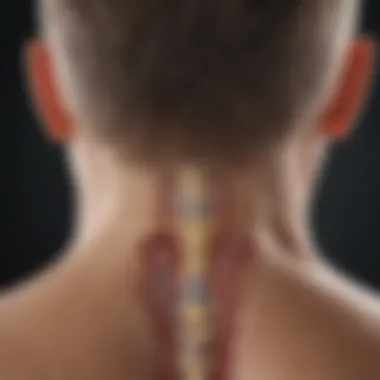
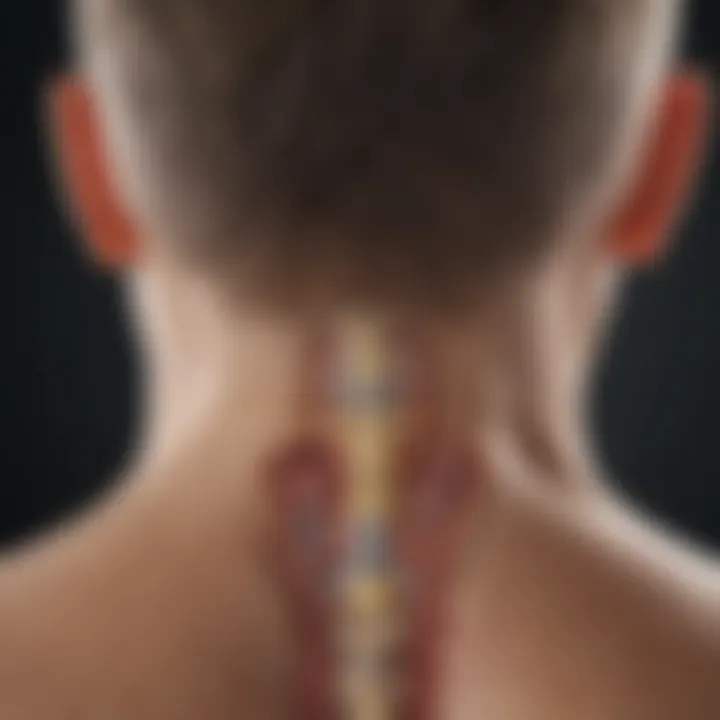
Following surgical interventions for stenosis of the intervertebral foramina, postoperative care and rehabilitation plays a pivotal role in a patient’s recovery trajectory. The importance of these processes cannot be overstated, as they directly influence the success of the surgical procedure and the overall quality of life for the patient. Effective postoperative care encompasses not just the physical recovery but also psychological support and patient education.
One of the key elements in postoperative care is the careful monitoring of the surgical site. Proper wound care ensures that infections or complications can be promptly addressed. Additionally, pain management is crucial during the initial recovery period. Patients often experience varying levels of discomfort after surgery, and healthcare providers need to deploy a tailored approach to manage pain while minimizing side effects from medications. This combination of attentive care can foster quicker recovery and enhance patient satisfaction.
Moreover, understanding the risks and complications associated with surgery equips both professionals and patients with the necessary knowledge to facilitate recovery effectively. Early mobilization, when appropriate, can stimulate circulation and assist in preventing complications like blood clots or pneumonia. It also serves to rebuild the patient’s confidence in their physical abilities post-surgery.
"A well-planned rehabilitation strategy can make the difference between a patient returning to a fulfilling lifestyle and experiencing prolonged disability."
Importance of Follow-Up
Regular follow-up appointments post-surgery are essential in ensuring a patient’s recovery is on track. These visits allow healthcare providers to monitor healing, assess functionality, and address any emerging concerns.
In essence, follow-ups provide an opportunity for medical professionals to:
- Evaluate the surgical site for any signs of complications.
- Adjust pain management strategies based on patient feedback.
- Guide rehabilitation efforts, ensuring exercises are performed correctly and safely.
- Reassess the original goals of the surgery and gauge progress.
For patients, these follow-ups can serve as reassurance, confirming that their recovery is following a favourable path. Moreover, being regularly engaged with their healthcare team often promotes adherence to rehabilitation protocols and motivation in their recovery journey.
Rehabilitation Protocols
Rehabilitation is typically divided into phases that cater to the patient’s recovery stage. A tailored rehabilitation protocol addresses not just physical healing but also regaining function. Key components include:
- Initial Rest and Mobility: This phase focuses on gentle movements to prevent stiffness and encourage healing. Healthcare providers often recommend light stretching and intentional walking to maintain circulation.
- Strengthening Exercises: As healing progresses, strengthening exercises aimed at core stability begin. These are vital for recovering function and preventing future issues. Gradually, exercises are introduced that focus on the back, abdomen, and legs.
- Functional Training: This aspect of rehabilitation helps patients regain confidence in daily activities. It can include balance exercises and specific movements needed for functional tasks, like bending or lifting.
- Education on Body Mechanics: Patients are taught proper body mechanics to minimize strain during activities, which is crucial in preventing re-injury.
- Psychosocial Components: Addressing psychological well-being is just as important, given that surgery can be fraught with anxiety. Support groups or therapeutic sessions can offer emotional relief and strategies to deal with the recovery phase.
In summary, robust postoperative care and rehabilitation offers a composite strategy aimed at not only restoring physical functioning but also enhancing a patient's overall wellness. This multifaceted approach evolves alongside the patient's recovery and ultimately fosters a smooth transition back to daily life.
Quality of Life Considerations
When discussing stenosis of the intervertebral foramina, it's essential to factor in the quality of life for those affected. Many patients experience not just physical limitations but also emotional and psychological challenges driven by this condition. As we delve into this subject, we will explore several key elements that underline the importance of holistic patient care and ongoing support throughout the entire spectrum of their treatment.
Patient Education and Support
Providing ample patient education and support plays a pivotal role in managing stenosis. Patients are often left in the dark about their condition, leading to uncertainty and fear. By equipping them with comprehensive information, healthcare providers can demystify the prognosis and treatment options. Here are several aspects to consider:
- Understanding the Condition: It's crucial for patients to know what stenosis is, how it occurs, and what specific parts of their anatomy are affected. Knowledge fosters empowerment, allowing patients to make informed decisions.
- Navigating Treatment Options: Different management methods, from conservative options to surgical interventions, can be overwhelming. Clearly laying out pros and cons can help patients grasp what to expect as they navigate their treatment pathways.
- Support Groups and Resources: Encouraging connections with support groups or an online community can provide emotional backing. Talking with others who have similar experiences can make a world of difference.
"Knowledge is power. The more patients know about their condition, the better equipped they are to handle it."
Long-term Outcomes
Exploring the long-term outcomes associated with intervertebral foraminal stenosis is key to understanding its impact on life after diagnosis and treatment. Notably, several factors contribute to the long-term prognosis:
- Effectiveness of Treatment: The success of treatment, whether surgical or conservative, can dictate recovery speed and ultimately, quality of life. The alignment of treatment with the individual patient's needs is vital.
- Adaptation: Patients often need to adapt their lifestyle following treatment to mitigate future episodes or complications. Education on posture, exercise, and activities of daily living is indispensable.
- Monitoring and Follow-Up: Regular follow-ups allow for early detection of any recurrences. Keeping an eye on their progress reinforces patient trust in the healthcare system and aids in adjustments to their management plan as needed.
Future Directions in Research
Research in the realm of intervertebral foraminal stenosis is crucial, as it opens avenues for better clinical practices and enhanced patient outcomes. This field needs ongoing investigation to optimize treatments and diagnostic techniques while also considering the long-term implications of the condition. Identifying how stenosis interacts with specific demographics, such as age and physical activity levels, can fine-tune both proactive and reactive healthcare strategies. As we look ahead, several key areas warrant attention.
Emerging Therapies
Recent studies are paving the way for innovative therapeutic approaches aimed at alleviating the symptoms of foraminal stenosis. These emerging therapies could transform patient care strategies significantly. For instance:
- Regenerative Medicine: This area focuses on using biologics, like stem cells, to repair damaged tissues surrounding the intervertebral foramina. This approach is not just about symptomatic relief; it aspires to restore functional integrity.
- Gene Therapy: Exploring the potential for gene-editing technologies to correct or modify genetic predispositions to conditions contributing to stenosis is in its infancy. The promise lies in tailoring interventions to individual genetic profiles, which could lead to more effective treatments.
- Minimally Invasive Techniques: With advancements in technology, minimally invasive procedures are becoming more prevalent. Techniques like endoscopic surgery minimize collateral damage to surrounding tissues.
"Innovative treatments hold a glimmer of hope for enhancing quality of life in patients suffering from foraminal stenosis."
Advancements in Diagnostic Techniques
The landscape of diagnostic methodologies for foraminal stenosis is constantly evolving. In particular, the development of advanced imaging technologies is noteworthy. Here are some key enhancements to consider:
- 3D Imaging: Traditional two-dimensional imaging often masks the complexity of the spinal anatomy. Advances in three-dimensional modalities provide a clearer picture and allow for more precise localization of stenotic regions.
- Functional MRI (fMRI): This technique measures brain activity by detecting changes associated with blood flow. While it's primarily used for neurological studies, its application in assessing nerve function related to foraminal stenosis is an area ripe for exploration.
- Artificial Intelligence (AI): The integration of machine learning algorithms in interpreting diagnostic images could drastically reduce human error. AI has the potential to predict outcomes based on existing data, allowing clinicians to tailor treatment plans more accurately.
- Ultrasound: Although not traditionally employed for this purpose, ultrasound is gaining attention for its ability to visualize soft tissues dynamically. Coupled with other imaging methods, it can offer real-time insights.
In summary, the future of intervertebral foraminal stenosis research looks promising, with potential breakthroughs in both therapeutic interventions and diagnostic methodologies. As this field progresses, healthcare professionals must stay abreast of these developments, which can influence methodologies and improve patient care in meaningful ways.
The End
The final chapter of our exploration sheds light on the overall significance of understanding stenosis of the intervertebral foramina. This article underscores not only the nuances of this condition but also its bearing on the overall health and well-being of individuals affected by it. Stenosis can result in various complications if not addressed adequately, affecting not just the physiological framework of the body but also the mental and emotional facets of a patient's life.
To encapsulate, recognizing the symptoms early on, diagnosing the ailment with precision, and implementing appropriate treatment strategies form the bedrock of effective patient care. Given the complexities involved with spinal health, it's crucial for healthcare experts, students, and researchers to stay updated with the latest practices in managing intervertebral foraminal stenosis.
Understanding this condition delves beyond mere anatomy and pathology. It invites practitioners to consider the multidisciplinary approaches we can adopt, including physical therapy techniques and innovative surgical methodologies. The emphasis on conservative management initially, followed by surgical options as a last resort, reflects sound medical principles aimed at risks mitigation.
To echo the words of a healthcare professional, "Knowledge breeds proactive engagement," suggesting that deeper insights promote awareness and facilitate better patient outcomes. Thus, the implications of this article extend well into future practices, encouraging continuous education and research in the field of spinal health.
Summary of Key Insights
Across our examination of intervertebral foraminal stenosis, several key insights emerge:
- Recognition of Symptoms: Early signs such as pain, numbness, or weakness signal the need for immediate attention.
- Diagnosis Protocols: Employing comprehensive imaging techniques coupled with electrophysiological studies aids in precise diagnostics.
- Multimodal Treatment Approaches: Combining conservative and surgical methods can enhance recovery and maintain quality of life.
- Patient Education: Equipping patients with knowledge about their conditions fosters better management and compliance with treatment plans.
These insights are pivotal for students, researchers, and healthcare professionals alike, as they cultivate a deeper understanding of the repercussions of foraminal stenosis, prompting thoughtful discussions around treatment paradigms.
Implications for Future Practice
Looking ahead, the landscape of managing intervertebral foraminal stenosis holds several implications for future medical practices:
- Research Advancements: Continuous investigation into innovative therapies and management protocols is essential. This includes looking into bioengineered solutions and minimally invasive surgical techniques.
- Interdisciplinary Collaboration: Encouraging partnerships between specialists in neurology, orthopedics, and pain management will lead to more holistic approaches.
- Personalized Medicine: Adapting treatment plans based on individual patient profiles ensures that care is tailored to the unique needs of each person, optimizing outcomes.
- Emphasis on Prevention: Focusing on preventive strategies, including lifestyle modifications and ergonomic assessments, may substantially reduce the incidence of stenosis.
All these considerations collectively present an opportunity to refine and improve patient experiences. Looking forward, a commitment to advancing our understanding and treatment of intervertebral foraminal stenosis not only enhances individual lives but also fortifies the healthcare field as a whole.



